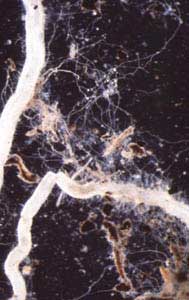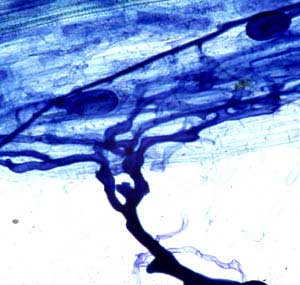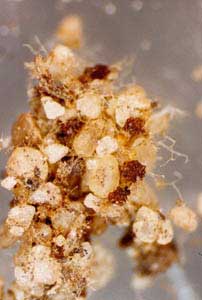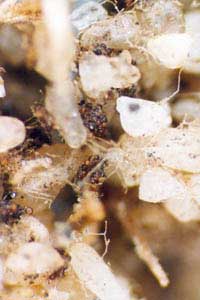Mycorrhizal fungi
This topic contains 11 questions:
- What are mycorrhizal fungi?
- What are the benefits of mycorrhizal associations?
- What are the four types of mycorrhizal associations and which plants are involved with them?
- What are arbuscular mycorrhizas?
- Can you see arbuscules and vesicles?
- What are the characteristic features of arbuscular mycorrhizal fungi from different genera?
- Can AM fungi survive in soil when plants are absent?
- How do broadacre agricultural practices affect AM fungi?
- How can vineyard management affect the benefit gained from mycorrhizal fungi?
- What are the main structural characteristics of ectomycorrhizal fungi?
- How do ectomycorrhizal fungi affect plants?
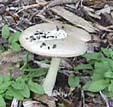
Question 1. What are mycorrhizal fungi?
Mycorrhizal fungi are fungi that form associations with plant roots that can be beneficial to both the plant and the fungi. Mycorrhizal fungi link the plant with soil by acting as agents of nutrient exchange. The fungi receive carbohydrates from the host plant root, which they use for energy, and the fungi passes nutrients such as phosphorus and zinc from the soil into the plant roots. Mycorrhizal associations may also decrease attack from root pathogens and increase the tolerance of the plant to adverse conditions such as heavy metals, drought, and salinity. In general, mycorrhizas play an important role in sustainable plant productivity and maintenance of soil structure.
Mycorrhizal associations occur on almost all terrestrial plants and are not as plant-specific as other plant-microbe associations that formed between some plants and bacteria (e.g. legumes and rhizobia).
“Some plant species, such as crucifers (i.e. broccoli) are unusual in that mycorrhizal symbioses are absent. Species with fine root hairs and many root hairs are not as dependent on mycorrhizae as species with well-defined tap roots” (Coyne, 1999).
Question 2. What are the benefits of mycorrhizal associations?
Question 3. What are the four types of mycorrhizal associations and which plants are involved with them?
The four kinds of mycorrhizal associations are formed by four different types of mycorrhizal fungi:
- Arbuscular mycorrhiza
- Ectomycorrhiza
- Ericoid mycorrhiza
- Orchid mycorrhiza
Most agricultural plants, vegetables and orchard plants form arbuscular mycorrhizal associations. Ectomycorrhizal associations are less common in disturbed ecosystems and are more commonly on perennial plants than annuals. Ornamental plants form associations from each of the four groups and orchid mycorrhizal associations are formed only by orchids.
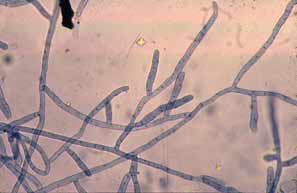
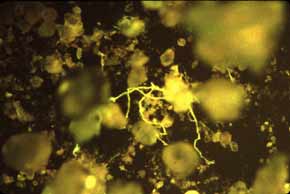
Question 4. What are arbuscular mycorrhizas?
Arbuscular mycorrhizas are roots with specific types of fungi inside them and in the surrounding soil. This type of mycorrhiza is formed by fungi in a group generally referred to as arbuscular mycorrhizal fungi. These fungi are characterised by having very thin threadlike structures, called hyphae, which are between 1 and 10 thousandths of a millimetre in width. (Hyphae is pronounced "high-fee"). The hyphae form networks between neighbouring soil particles, between roots and soil particles, between roots on the same plant, between roots of different plants (even different types of plants) and in the plant roots themselves. The networks of hyphae are also referred to as mycelium.
Arbuscular mycorrhizas are called this because they have developed a specific structure called an "arbuscule". Although some kinds of soil fungi can be associated with plant and animal disease, the fungi that form arbuscular mycorrhizas belong to a group of soil fungi that can be very beneficial. The name "mycorrhiza" means "fungus root" and this is derived from the close association of the fungi with plant roots - in fact, arbuscular mycorrhizal fungi cannot complete their life cycle unless they are connected to plant roots. Generally, it is not possible to grow these fungi without the support of the plant. The reasons for this are still largely unknown.
Mycorrhizas get their carbohydrates (which they use for energy) from the plant root they are living in/on and they usually help the plants by transferring phosphorus from the soil into the root.
This means they are important in soils that do not have enough phosphorus (relative to other nutrients) for plant growth. Mycorrhizas are particularly important for phosphate uptake because phosphorus does not move towards plant roots easily. Some nutrients (like nitrogen) are carried wherever the soil water moves, but phosphorus is not like this. Therefore, it is necessary for roots to intercept the phosphorus in the soil before it can be taken up into the plant. What the fungi do is extend the volume of soil that can be explored by the plant for phosphorus.
Thus, when phosphorus is scarce, plants that have developed mycorrhizas on their root systems can take up more phosphorus than plants with none or only small amounts of mycorrhizas. Although arbuscular mycorrhizas form on a majority of types of plants, there are some plants that do not form this type of mycorrhiza. Two examples are canola (oilseed rape) and lupin. Arbuscular mycorrhizas are found in natural ecosystems as well as in agricultural areas. They are common on both perennials and annuals. Arbuscular mycorrhizal fungi can also benefit the physical characteristics of the soil, because their hyphae form a mesh to help stabilize soil aggregates.
Arbuscular mycorrhizal fungi may also help to protect plants from root diseases present in the soil, and in some cases may help plants absorb copper and zinc from the soil. These are plant nutrients that behave in a similar way to phosphorus in soil and the plant roots need to explore the soil to intercept them. There are only 5 groups (called genera) of arbuscular mycorrhizal fungi and these are distributed throughout the world. They are known by their Latin names for the genera they belong in as: Acaulospora, Entrophosphora, Gigaspora, Glomus, and Scutelospora.
Question 5. What are arbuscules and vesicles?
Arbuscules are formed by mycorrhizal fungi inside a cell within a plant root. They are the places where the plant and the fungus exchange food and nutrients with each other. Carbon and phosphorus and other nutrients may also be exchanged though hyphae that ramify inside the root, but it is likely that the arbuscules are the major site for nutrient exchange. Arbuscules look a bit like minute sea anemones because they have many small projections that extend inside the plant cells. They are formed by repeated branching of a hypha when it enters a cell.
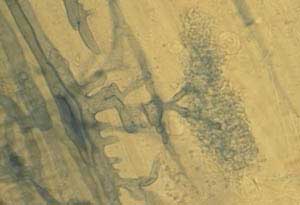
Vesicles are also structures formed inside the plants' roots. They look like an oval bag and most people believe that they are used for storing nutrients. Only three of the five genera of arbuscular mycorrhizas form vesicles (Glomus, Acaulospora and Entrophosphora).
![]()
Question 6. What are the characteristic features of arbuscular mycorrhizal fungi from different genera?
There are only 5 groups (called genera) of arbuscular mycorrhizal fungi:
- Glomus
- Acaulospora
- Entrophosphora
- Gigaspora
- Scutelospora
The fungi are grouped according to the size, shape and wall structure of their spores. The spores are approximately spherical or ovoid in shape and usually have thick walls so they can survive harsh environmental conditions. When soil conditions are favourable, the spores germinate and hyphae grow out of the spore. These hyphae can then enter roots and set up the mycorrhizal association.
Spores are between 30 and 500 micrometres in size - this is between 30 thousandths of a millimetre and half a millimetre. Identifying and classifying the spores is therefore something that must be done with the aid of microscopes.
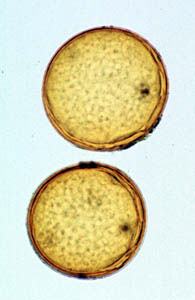
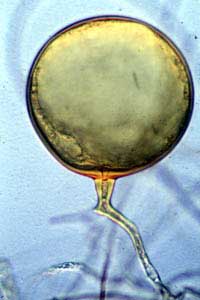
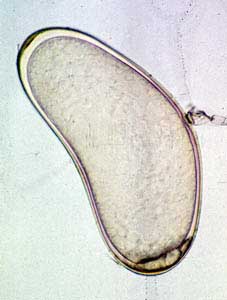
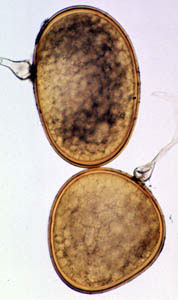
Also, fungi grow differently in roots depending on the type of fungus and the growth habit of the root itself.
.jpg)
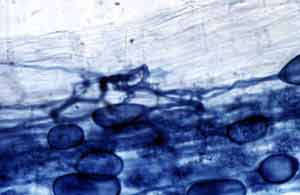
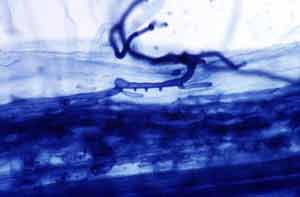
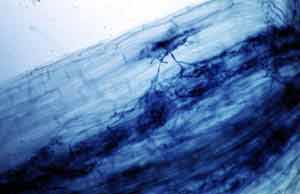
Question 7. Can arbuscular mycorrhizal fungi survive in soil when plants are absent?
Arbuscular mycorrhizal fungi can survive for long periods in soil, even when the soil is dry or frozen. Some fungi survive as pieces of hyphae in dead roots or in soil. However, arbuscular mycorrhizal fungi are not able to actively grow in soil for long periods in the absence of a host plant. Hyphae grow from spores or from within root fragments in soil when conditions are suitable, but they must make contact with a host plant to obtain the carbon and energy they need for long term growth.
Question 8. How do broadacre agricultural practices affect arbuscular mycorrhizal fungi?
- Phosphorus fertiliser. An extensive survey of wheat crops in Western Australia was funded by GRDC to determine the presence of arbuscular mycorrhizal fungi at early seedling stage and in spring. Most plants had low levels of mycorrhizas and this was related to high levels of phosphorus in the soil (measured using the sodium bicarbonate method). Generally, the quantities of mycorrhizas were not sufficient to benefit the phosphate nutrition of the wheat.
- Cultivation. In agricultural soils in the south west of Western Australia, cultivation does not usually affect the formation of arbuscular mycorrhizas. However in Canada, the growth of some agricultural plants was significantly restricted by cultivation, because the network of hyphae formed by the arbuscular mycorrhizal fungi was disrupted.
- Herbicides and fungicides. Generally, applying herbicides at the recommended level does not directly affect arbuscular mycorrhizal fungi. There may be other effects of the herbicide if the type of plant roots in the soil is changed, for example if weeds are removed. In addition, residual herbicides can restrict root development and this could alter the length of mycorrhizal root formed. Some fungicides decreased the amount of mycorrhizas that are formed.
- Crop rotation. In soils in the south west of Western Australia, the most significant effect of rotation on the presence of arbuscular mycorrhizal fungi is the increase that occurs during the pasture phases. This is because pasture phases include highly mycorrhizal plants like grasses, clover and other legumes and also because less phosphorus fertilizer is used. In addition, the common practice of including lupin and canola in rotations reduces the amount of arbuscular mycorrhizal fungi in the soil. Adding a pasture phase to the crop rotation helps to restore mycorrhizal function, increases the efficiency of phosphate fertilizer use and improves soil structure.
Question 9. How can vineyard management affect the benefit gained from mycorrhizal fungi?
Vineyard management practises could significantly affect the benefit gained by grapevines from mycorrhizas. However, the benefit is difficult to measure. Arbuscular mycorrhizal fungi provide most benefit to their host plants when phosphorus is applied at levels that are not too excessive. Applying high levels of phosphorus fertiliser to soil decreases the beneficial effect of arbuscular mycorrhizal fungi. This occurs because there is a decrease in the amount of mycorrhizas formed. Localised placement of phosphorus fertiliser or use of slow-release phosphorus might help the plant to get maximum benefits from mycorrhizas.
Also, it may be useful to inoculate grapevines at the rootling stage with species of arbuscular mycorrhizal fungi that can provide a benefit to the plant under vineyard conditions. However, more information about the survival of inoculated fungi is required to determine whether this is necessary.
Question 10. What are the main structural characteristics of ectomycorrhizal fungi?
There are three main structural characteristics of ectomycorrhizal fungi.
- Hyphae extend from the root through the soil surrounding the roots.
- The hyphal mat covers the surface of the root to varying degrees.
- The Hartig net is a net of hyphae that exists between the outer (epidermal) cells of roots.
Question 11. How do ectomycorrhizal fungi affect plants?
Ectomycorrhizal fungi also have the potential to positively affect plant growth. Ectomycorrhizal fungi can change the growth form of plant roots by promoting root branching and restricting root extension. Ectomycorrhizal fungi can increase the uptake of phophorus by plant roots and some species of fungi also improve nitrogen uptake. They can decrease the susceptibility of the plant to disease and drought. The hyphal mantle over the surface of the roots can provide protection against the entry of pathogenic soil fungi and the hyphal network in soil surrounding roots allows water uptake from more soil. These effects on plant growth combine to make the associated plant more robust and increase its chances of survival.
Search Site
- Soil Health
- Help/Feedback
- Contact us
- Sitemap


